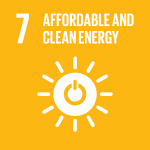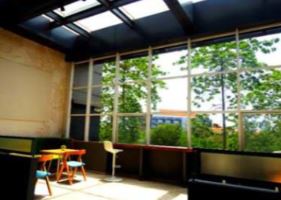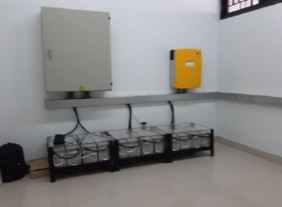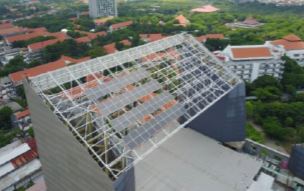“After water and food, energy is one of the key enablers of human life. Energy is central to nearly every major challenge and opportunity the world faces today and access to energy for all is essential. But energy needs to be available and affordable to all to allow future development, and it needs to be clean in order to ensure that the development can be sustainable.”
(THE Impact Rankings)
SDG 7: AFFORDABLE AND CLEAN ENERGY
University measures towards affordable and clean energy
ITS Policy about Sustainable and Environmental Friendly Campus Implementation
In order to encouraging the implementation of Sustainable and Environmental Friendly campus, ITS as a Smart Eco Campus issued Circular Letter of ITS Rector. It covered ways to maintaining environment, including the energy efficiency and conservation, as listed in item B 1-10. By implementing such policy, ITS ensures that the consumption of energy through electricity, technology device, and lighting system is allocated efficiently and effectively.
Energy-Efficient Renovation and Building
In order to encouraging the implementation of Sustainable and Environmental Friendly campus, ITS as a Smart Eco Campus implemented an energy-efficient and smart building in its 29 buildings. These buildings are subjected to fulfill those five requirements in order to become an energy-efficient: automation, safety, energy, water, indoor environment, and lighting. These matters determines whether such buildings considered smart building area.
Renewable Energy Sources
Following up Circular Letter of ITS Rector about Sustainable and Environmental Friendly campus, ITS utilizes three renewable energy sources (solar power, clean biomass, and biodiesel) with a total of 145,855 kWh per annum. ITS utilizes a total of nine solar powers, complemented with biogas and gasification. This represents ITS commitment in preserving energy efficiency and conservation, along with technology utilization in keeping the energy consumption efficient.
Upgrade Buildings to Higher Energy Efficiency
Referring to the Circular Letter of ITS Rector, buildings located in ITS are being upgraded into a higher energy-efficiency by maximizing sanitation, and implementing solar power in them. Furthermore, these buildings are subjected to fulfill those five requirements in order to become an energy-efficient: automation, safety, energy, water, indoor environment, and lighting. These matters determines whether such buildings considered smart building area.
Energy-Efficient Renovation and Building
In order to encouraging the implementation of Sustainable and Environmental Friendly campus, ITS as a Smart Eco Campus implemented an energy-efficient and smart building in its 29 buildings. These buildings are subjected to fulfill those five requirements in order to become an energy-efficient: automation, safety, energy, water, indoor environment, and lighting. These matters determines whether such buildings considered smart building area.
Renewable Energy Sources
Following up Circular Letter of ITS Rector about Sustainable and Environmental Friendly campus, ITS utilizes three renewable energy sources (solar power, clean biomass, and biodiesel) with a total of 145,855 kWh per annum. ITS utilizes a total of nine solar powers, complemented with biogas and gasification. This represents ITS commitment in preserving energy efficiency and conservation, along with technology utilization in keeping the energy consumption efficient.
Greenhouse Gas Emission Reduction Program
ITS in its Smart Eco Campus implementation also keeps tabs on Greenhouse Gas (GHG) emission implications by initiating Greenhouse Gas Emission Reduction Program. This program consists of four scopes, covering from combustion to waste matters. Moreover, not only greenhouses gas emissions that are taken into account, but ITS also pays attention to the number of carbon footprints omitted.
Energy Consumption Reduction
ITS as a Smart Eco Campus commences a green building campaign, and it is implemented in each of ITS’ building development and renovation. Such campaign will be focusing on the following elements: natural lighting, natural ventilation, building’s heat load reduction, vertical garden, water efficiency, solar cell installation as an ITS renewable energy, and construction of buildings above ground that provide space for rainwater. Furthermore, this campaign is also subject to the Circular Letter of ITS Rector, referring to Sustainable and Environmental Friendly Campus in ITS.
Sustainable Commuting Practices
ITS as a Smart Eco Campus initiates a program focusing on reducing the usage of private transportation. Such programs encourage all the staff, lecturers, and students to ride a bike or walk instead of using electrical vehicles inside the campus area. This encouragement is also supported by the partnership between ITS and the Local Government of Surabaya regarding the route of Suroboyo Bus in which ITS becomes a part of the route. Furthermore, not only bus, but ITS also provides a free bike that is available to be rented with particular terms and conditions. This practice represents ITS readiness to strive timelessly towards vehicle emissions in the campus areas.
Circular Letter of ITS Rector about ITS’ Initiatives towards Sustainable and Environmental-Friendly Campus
In order to promote the pledge toward 100% renewable energy, ITS issued a Circular Letter of ITS Rector regarding Sustainable and Environmental Friendly Campus, which contains ten lists of efforts in conservating energy efficiently. Such efforts yet remain to maximize the effectiveness of some types of equipment: energy-saving electrical equipment, lighting devices, air conditioners, elevator operation, and fuel consumption as well. This policy should be obliged by all ITS academic communities (lecturers, staff, and students) in order to succeed ITS Smart Eco Campus program.
Renewable Energy Sources
Following up Circular Letter of ITS Rector about Sustainable and Environmental Friendly campus, ITS utilizes three renewable energy sources (solar power, clean biomass, and biodiesel) with a total of 145,855 kWh per annum. ITS utilizes a total of nine solar powers, complemented with biogas and gasification. This represents ITS commitment to preserving energy efficiency and conservation, along with technology utilization in keeping the energy consumption efficient.
Energy Consumption Reduction
ITS as a Smart Eco Campus commences a green building campaign, and it is implemented in each of ITS’ building development and renovation. Such campaign will be focusing on the following elements: natural lighting, natural ventilation, building’s heat load reduction, vertical garden, water efficiency, solar cell installation as an ITS renewable energy, and construction of buildings above ground that provide space for rainwater. Furthermore, this campaign is also subject to the Circular Letter of ITS Rector, referring to Sustainable and Environmental Friendly Campus in ITS.
Renewable Energy Sources
Following up Circular Letter of ITS Rector about Sustainable and Environmental Friendly campus, ITS utilizes three renewable energy sources (solar power, clean biomass, and biodiesel) with a total of 145,855 kWh per annum. ITS utilizes a total of nine solar powers, complemented with biogas and gasification. This represents ITS commitment to preserving energy efficiency and conservation, along with technology utilization in keeping the energy consumption efficient.
Energy Consumption Reduction
ITS as a Smart Eco Campus commences a green building campaign, and it is implemented in each of ITS’ building development and renovation. Such campaign will be focusing on the following elements: natural lighting, natural ventilation, building’s heat load reduction, vertical garden, water efficiency, solar cell installation as an ITS renewable energy, and construction of buildings above ground that provide space for rainwater. Furthermore, this campaign is also subject to the Circular Letter of ITS Rector, referring to Sustainable and Environmental Friendly Campus in ITS.
Solar Panel Monitoring
Solar Panel Monitoring ITS as a Smart Eco Campus has implemented solar panel monitoring at the ITS Research Center Building. A solar power plant has been installed and it has been monitored by the PLTS Plant Alfa ITS system, which shows the overview of indicators such as the number of energy produced monthly and annually. By implementing such monitoring, ITS strives to preserve the efficiency and the effectiveness of energy usage.
Circular Letter of ITS Rector about ITS’ Initiatives towards Sustainable and Environmental-Friendly Campus
In order to promote the pledge toward 100% renewable energy, ITS issued a Circular Letter of ITS Rector regarding Sustainable and Environmental Friendly Campus, which contains ten lists of efforts in conservating energy efficiently. Such efforts yet remain to maximize the effectiveness of some types of equipment: energy-saving electrical equipment, lighting devices, air conditioners, elevator operation, and fuel consumption as well. This policy should be obliged by all ITS academic communities (lecturers, staff, and students) in order to succeed ITS Smart Eco Campus program.
Renewable Energy Sources
Following up Circular Letter of ITS Rector about Sustainable and Environmental Friendly campus, ITS utilizes three renewable energy sources (solar power, clean biomass, and biodiesel) with a total of 145,855 kWh per annum. ITS utilizes a total of nine solar powers, complemented with biogas and gasification. This represents ITS commitment to preserving energy efficiency and conservation, along with technology utilization in keeping the energy consumption efficient.
Energy Consumption Reduction
ITS as a Smart Eco Campus commences a green building campaign, and it is implemented in each of ITS’ building development and renovation. Such campaign will be focusing on the following elements: natural lighting, natural ventilation, building’s heat load reduction, vertical garden, water efficiency, solar cell installation as an ITS renewable energy, and construction of buildings above ground that provide space for rainwater. Furthermore, this campaign is also subject to the Circular Letter of ITS Rector, referring to Sustainable and Environmental Friendly Campus in ITS.
Energy and the community
ITS Develops a Renewable Energy-based Herbal Edutourism
The Center for the Study of Public Policy, Business, and Industry (PKKPBI) of ITS is back to innovation for the country. Along with the Panderman Batu Forest Farmers Group and the Batu City Government, ITS developed a herbal education area based on renewable energy and circular economy which was inaugurated by marking the laying of the first stone. This collaboration becomes the first step for ITS to contribute and innovate in the edutourism business and herbal research.

ITS Develops Micro-Hydro Power Plant
ITS is a campus that actively participates in the welfare of the Indonesian people in various aspects. This time, the ITS Community Services Program (KKN) team organize community service by utilizing water flow in the village to produce electrical energy in order to improve the village economy. The electricity generated then will be utilized as a power in supplying public needs, such as public street lighting (PJU), water reservoirs, and houses of worship.

#EnergiMuda Innovation: Let’s Build a Nation with Clean Energy!
Higher education has aware of the importance of environmentally friendly clean energy by developing renewable energy through various innovations. The current challenge lies in how initiatives and innovations from the education sector are able to develop and be captured by the industrial sector (link and match) in order to enlarge the green jobs market. Indonesia Koaksi presented ITS Marine Solar Boat Team (ITS MSBT) as one of the participants who presents the best work in the field of renewable energy.

Circular Letter of ITS Rector about ITS’ Initiatives towards Sustainable and Environmental Friendly Campus
In order to promote the pledge toward 100% renewable energy, ITS issued a Circular Letter of ITS Rector regarding Sustainable and Environmental Friendly Campus, which contains ten lists of efforts in conservating energy efficiently. Such efforts yet remain to maximize the effectiveness of some types of equipment: energy-saving electrical equipment, lighting devices, air conditioners, elevator operation, and fuel consumption as well. This policy should be obliged by all ITS academic communities (lecturers, staff, and students) in order to succeed ITS Smart Eco Campus program.
Renewable Energy Installation and Its Implementation
In moving towards the vision of becoming a sustainable and environmental-friendly campus, as well as to realize the ITS Smart Eco Campus Program, ITS has a commitment to strive for energy efficiency and conservation by undertaking energy efficiency program, lighting and electricity efficiency, technology utilization encouragement, and maximizing the use of ventilation as well.
Energy Saving and Efficiency
The earth provides energy as a basic need for living things. However, it is imperative to save energy in order to reduce greenhouse gas (GHG) emissions and preserve environmental health. Efforts to save and make energy-efficient at the ITS campus are supported by research and development from various research and excellence centers, including solar panel energy, biomass energy (biogas and waste power plants) to biodiesel. The Smart Building application is applied to buildings on the ITS campus to maximize the building’s energy efficiency.
ITS Develops a Renewable Energy-based Herbal Edutourism
The Center for the Study of Public Policy, Business, and Industry (PKKPBI) of ITS is back to innovation for the country. Along with the Panderman Batu Forest Farmers Group and the Batu City Government, ITS developed a herbal education area based on renewable energy and circular economy which was inaugurated by marking the laying of the first stone. This collaboration becomes the first step for ITS to contribute and innovate in the edutourism business and herbal research.

Expanding Cooperation, ITS Signs MoU with PT BGR
ITS is increasingly ready to play a role in developing education, research, and community empowerment by expanding cooperation networks. The expanding networks are evidenced by the signing of a Memorandum of Understanding (MoU) with PT Bhanda Ghara Reksa (Persero) or PT BGR which is engaged in logistics and delivery of goods. The MoU signing then proceeded to these three cooperation topics: the program for the management and utilization of used cooking oil, endorsement of Food Stalls, and halal assistance for Food Stalls Partners’ products.

ITS and PAG Cooperate in Joint Exploration of Energy Resources
ITS and PT PAG conducted Joint Exploration and Energy Resources in order to expand the collaboration between Surabaya and Aceh. The main activity is processing gas sourced from North Sumatra Offshore (NSO), an offshore platform 100 kilometers to the sea. The implementation of this joint exploration represents ITS readiness to be at the forefront and a pioneer in advancing the fields of engineering, social, economic, and data sources by widening the wings of its cooperation.

Expanding Cooperation, ITS Signs MoU with PT BGR
ITS is increasingly ready to play a role in developing education, research, and community empowerment by expanding cooperation networks. The expanding networks are evidenced by the signing of a Memorandum of Understanding (MoU) with PT Bhanda Ghara Reksa (Persero) or PT BGR which is engaged in logistics and delivery of goods. The MoU signing then proceeded to these three cooperation topics: the program for the management and utilization of used cooking oil, endorsement of Food Stalls, and halal assistance for Food Stalls Partners’ products.

ITS Cooperates Internationally in The Use of Low Carbon Materials
ITS continues to unleash its efforts to compete in the international arena. This time through an international cooperation program between the Department of Civil Engineering ITS, which is driven by concrete laboratories and building materials, with Heriot-Watt University (HWU), Edinburgh, Scotland. This activity is an international workshop with the theme of PROMOTE: Promote the Utilisation of Low-carbon Concrete through Performance Testing. It is also expected to provide benefits from the increasing side of understanding related to the use of low carbon materials in the construction world, especially buildings, bridges, and others.
Indonesia Power Encourages ITS to Research and Create “Smart Stoves”
Along with technological advances that are growing rapidly, electric stoves usage is an option for some people, especially in urban areas who are required to be compact and simple. Therefore, Indonesia Power took the initiative to invite ITS to work together in conducting applied research on the development of a new generation of electric stoves (Smart stoves). Such stoves are expected soon to be produced and used widely in the community safely and at low prices.

Utilizing Renewal Energy, ITS Students Initiate Business Ideas
Due to the government’s policy of Work From Home during the Covid-19 pandemic, the consumption of household electricity raised rapidly. Referring to such matters, four ITS students initiate an innovation as well as a business idea called Povitts, a mobile application for household Photovoltaics (PV) service consulting service providers. This can be a means for the community to increase knowledge about New and Renewable Energy (NRE) sources.

Welcoming the Clean Energy Era, Cenits Holds an RTD
Developing Transportation by the Sustainable Cities and Communities is an important step to raise awareness of environmentally friendly energy issues. Addressing this, Cenits (Centre for Energy and Innovation Technology Studies) with ITS Alumni Association (IKA) of Institut Teknologi Sepuluh Nopember (ITS) Regional Board (PW) in East Java held a Round Table Discussion (RTD) with the theme Readiness to welcoming clean energy era and 5G technology in the transportation and industry sector. The RTD also discussed transportation and industrial readiness in Indonesia regarding the readiness of welcoming the clean energy era.
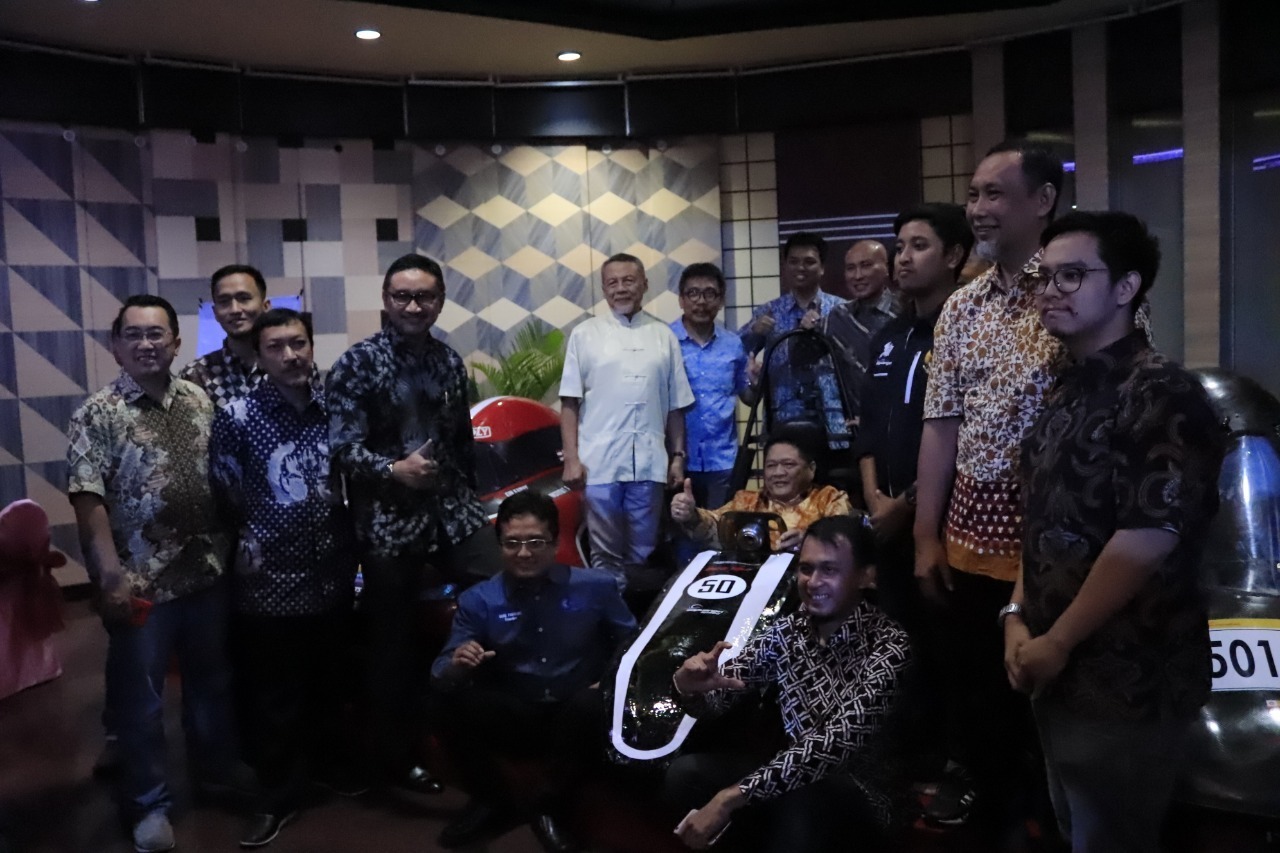
ITS Students Innovation to Use Biomass as an Electric Charger
The biogas-type biomass sources from cow dung in Indonesia are very abundant, but their use is still limited to household gas materials. Seeing this great opportunity, the student team of ITS succeeded in initiating the use of a biogas energy source in the form of a charging station for charging batteries. By initiating such biogas energy usage, hopefully, it can be used optimally and can support electric vehicles in Indonesia.
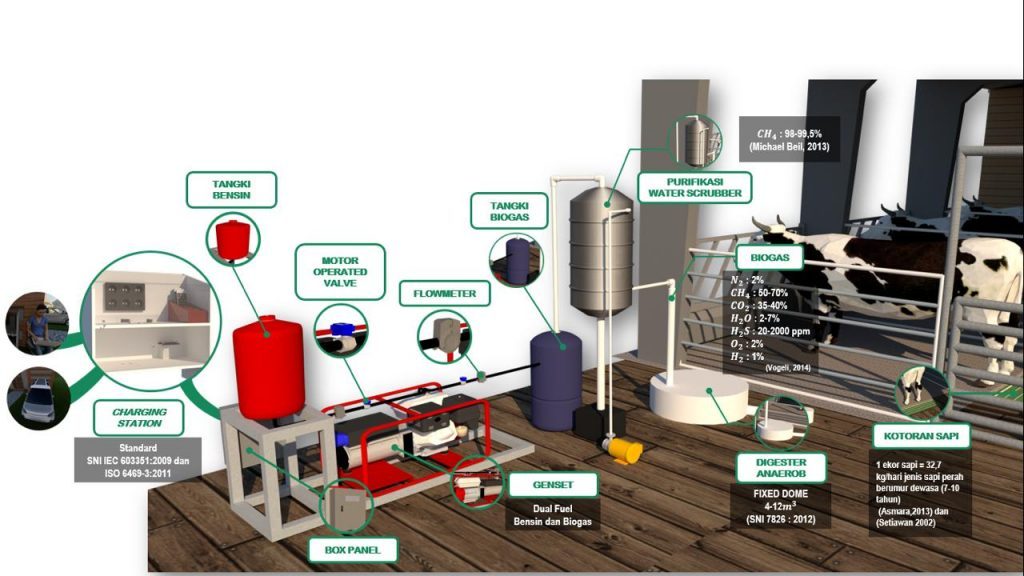
SDG 7 IN NUMBERS
12,261,755 kWh
Total energy consumption
528,225 m2
University floor space
0.084
Total energy consumption per sqm
